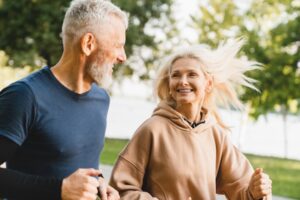 Age-related muscle mass loss — called “sarcopenia” — is expected. It is thought that you lose 3-8% per decade after age 30. This leads to a decrease in the number and size of muscle fibers. The decline is even steeper after age 50. You should try to build up your muscle mass before that age. Our InBody Scan will help you assess where you are currently.
Age-related muscle mass loss — called “sarcopenia” — is expected. It is thought that you lose 3-8% per decade after age 30. This leads to a decrease in the number and size of muscle fibers. The decline is even steeper after age 50. You should try to build up your muscle mass before that age. Our InBody Scan will help you assess where you are currently.
Why should you care?
- Less muscle means you are weaker
- Lower stamina
- Inability to climb stairs
- Less muscle increases your risk of falls and broken bones: A study from the American Society for Bone and Mineral Research found those with lower muscle mass had a 2.3x risk of having a fracture after a fall. (Broken hip, clavice, leg, arm, or wrist)
- Frailty is an enormous concern when you age: This affects your ability to exercise and do daily life activities like shopping/cooking/cleaning/bathing. This can lead to an inability to live independently.
- If older than age 65, there is a general questionnaire to assess your level called SARCF: Strength, Assistance with walking, Rising from a chair, Climbing stairs, Falls. You score 0-2 in each category, and a score of 4 or more should have additional testing.
- In performing testing, there are tests to look at handgrip strength (as it correlated to other muscles), the chair stand test (where you stand and sit in a chair as many times without your arms as you can in 30 seconds), and the walking speed test.
How to Prevent:
Use it or lose it is accurate. But there are other things you can do:
- Testosterone helps build muscle. Test your level and see if supplementation is useful for you.
- Progressive resistance training, where you increase the weight, number of reps, and number of sets to increase your strength and endurance. Try to do 10 exercises targeting different groups. Do reps of 10-15 with moderate exertion. Aim for 2-3 workouts a week of strength training. This is not cardio — the goal is to build and maintain muscle.
- Protein — The goal for most is 1g/kg a day. Your body breaks down protein into amino acids to build muscle. Your ability to do that declines as you age. Animal sources are considered best.
- NAD — This is an area where we see how many patients on NAD feel a big increase in their ability to build muscle mass.
- Speed — There is thought that doing things faster — getting up out of a chair, walking faster, etc. — helps preserve muscle.
How can Biohackr Health help?
- TESTING. What are your hormone levels? NAD levels?
- InBody SCAN. This is a non-invasive measurement of your current body state: muscle mass, water, and body fat. It will help you see your baseline and evaluate your progress.
- NAD. We offer IV infusions and oral (NMN) to improve your levels.
- HORMONE REPLACEMENT. We do bioidentical hormone replacement.
- SERMORELIN, which helps your body produce more hGH.
- GLUTATHIONE, a potent antioxidant.
- IV TREATMENTS. Amino acids, Fitness IVs.
- RECOVERY. When doing a big race or training, pre-race NAD or IVs followed by EBO2 to assist recovery.
We are here to help you. Come on in and get assessed to see where you are starting from and how we can optimize you.
The information provided on this website is for general informational purposes only and does not constitute medical advice, diagnosis, or treatment. Always seek the advice of a qualified healthcare provider for any questions regarding your health or medical condition.